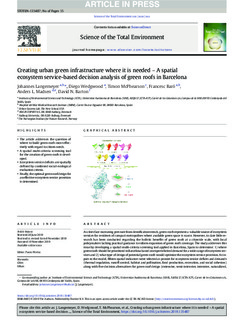| dc.contributor.author | Langemeyer, Johannes | |
| dc.contributor.author | Wedgwood, Diego | |
| dc.contributor.author | McPhearson, Timon | |
| dc.contributor.author | Baró, Francesc | |
| dc.contributor.author | Madsen, Anders L. | |
| dc.contributor.author | Barton, David Nicholas | |
| dc.coverage.spatial | Spania, Spain, Barcelona | nb_NO |
| dc.date.accessioned | 2020-01-02T15:13:03Z | |
| dc.date.available | 2020-01-02T15:13:03Z | |
| dc.date.issued | 2019 | |
| dc.identifier.issn | 0048-9697 | |
| dc.identifier.uri | http://hdl.handle.net/11250/2634660 | |
| dc.description.abstract | As cities face increasing pressure fromdensification trends, green roofs represent a valuable source of ecosystem services for residents of compact metropolises where available green space is scarce. However, to date little Research has been conducted regarding the holistic benefits of green roofs at a citywide scale, with local policymakers lacking practical guidance to inform expansion of green roofs coverage. The study addresses this issue by developing a spatial multi-criteria screening tool applied in Barcelona, Spain to determine: 1) where green roofs should be prioritized in Barcelona based on expert elicited demand for a wide range of ecosystemservices
and 2) what type of design of potential green roofs would optimize the ecosystem service provision. As inputs to the model, fifteen spatial indicators were selected as proxies for ecosystem service deficits and demands (thermal regulation, runoff control, habitat and pollination, food production, recreation, and social cohesion) along with five decision alternatives for green roof design (extensive, semi-intensive, intensive, naturalized,and allotment). These indicators and alternativeswere analyzed probabilistically and spatially, thenweighted according to feedback from local experts. Results of the assessment indicate that there is high demand across Barcelona for the ecosystem services that green roofs potentially might provide, particularly in dense Residential neighborhoods and the industrial south. Experts identified habitat, pollination and thermal regulation as the most needed ES with runoff control and food production as the least demanded. Naturalized roofs generated the highest potential ecosystemservice provision levels for 87.5% of rooftop area, apart fromsmaller areas of Central Barcelona where intensive rooftops were identified as the preferable green roof design. Overall, the spatial model developed in this study offers a flexible screening based on spatial multi-criteria decision analysis that can be easily adjusted to guide municipal policy in other cities considering the effectiveness of green infrastructure as source of ecosystem services. | nb_NO |
| dc.language.iso | eng | nb_NO |
| dc.rights | Attribution-NonCommercial-NoDerivatives 4.0 Internasjonal | * |
| dc.rights.uri | http://creativecommons.org/licenses/by-nc-nd/4.0/deed.no | * |
| dc.subject | Cities | nb_NO |
| dc.subject | Urban | nb_NO |
| dc.subject | Nature-based solutions (NBS) | nb_NO |
| dc.subject | Green infrastructure (GI) | nb_NO |
| dc.subject | Bayesian Belief Networks (BBN) | nb_NO |
| dc.subject | Multi-criteria decision analysis (MCDA) | nb_NO |
| dc.title | Creating urban green infrastructure where it is needed – A spatial ecosystem service-based decision analysis of green roofs in Barcelona | nb_NO |
| dc.type | Peer reviewed | nb_NO |
| dc.type | Journal article | |
| dc.description.version | publishedVersion | nb_NO |
| dc.rights.holder | © 2019 The Authors. | nb_NO |
| dc.subject.nsi | VDP::Samfunnsvitenskap: 200::Økonomi: 210 | nb_NO |
| dc.source.journal | Science of the Total Environment | nb_NO |
| dc.identifier.doi | 10.1016/j.scitotenv.2019.135487 | |
| dc.identifier.cristin | 1765432 | |

